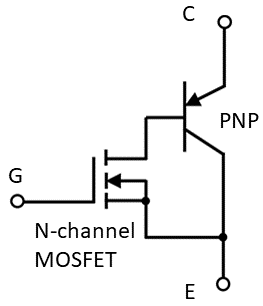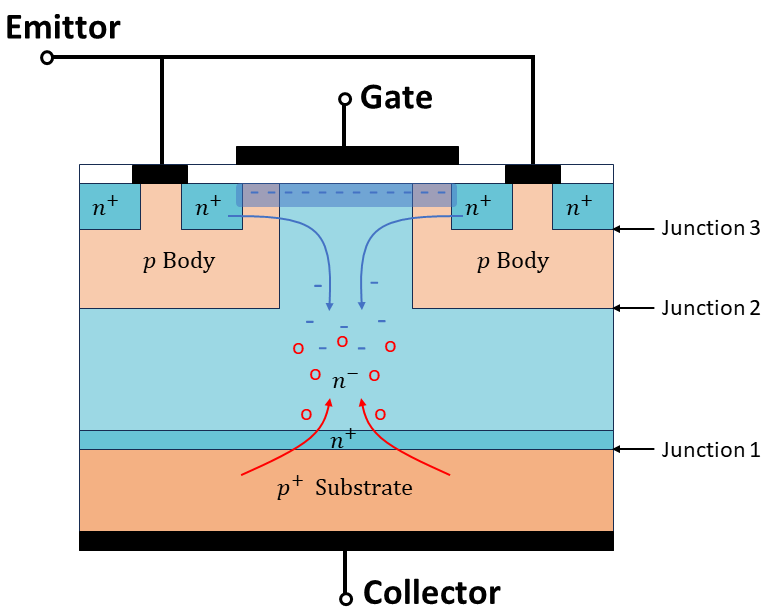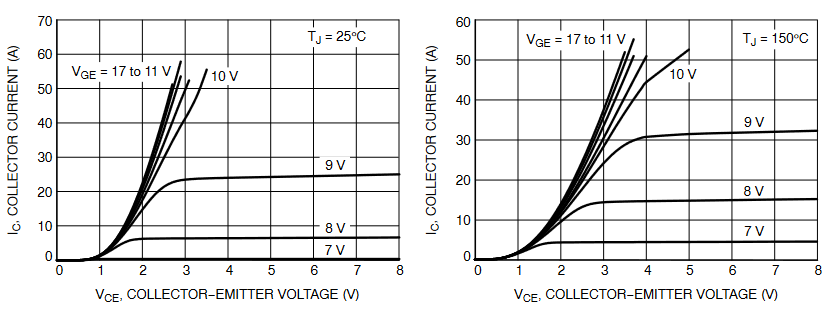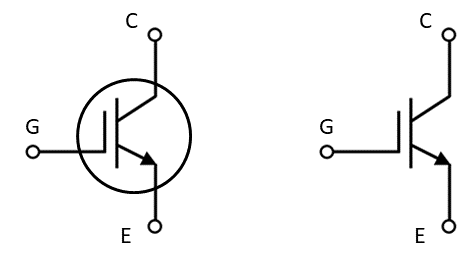In this article the 3-phase IGBT inverter and its functional operation are discussed. In order to realize the 3-phase output from a circuit employing dc as the input voltage, a 3-phase (IGBT) inverter has to be used. The inverter is build of switching devices, thus the way in which the switching takes place in the inverter gives the required output. In this article the concept of IGBT’s and the working principle of the inverter is explained.
1. Insulated Gate Bipolar Transistor
The Insulated Gate Bipolar Transistor, also called IGBT, is something of a cross between a metal-oxide-semiconductor field-effect transistor (MOSFET) with a bipolar junction transistor (BJT). It can be used as a semiconductor switching device. The IGBT takes the insulated gate technology of a MOSFET (hence the first part of the name) and combines it with the output performance characteristics of a BJT, (hence the second part of the name). As a result, the IGBT has the output switching characteristics of the BJT, but can be voltage controlled, such as a MOSFET. It takes the best of both worlds.
It can be used in small amplifying circutis, replacing BJTs and MOSFETs. But because it has a very low “on-state” resistance, lower then the other two, it has very low power loss (![]() ). Due to this, and the fact that it is capable of handing large currents (1000+ Amps) with basically zero gate current, it is mainly used in power electronics, such as power supplies and inverters. Even though high power BJTs exist, their switching speed is much lower than these IGBTs, making this the ideal device to use.
). Due to this, and the fact that it is capable of handing large currents (1000+ Amps) with basically zero gate current, it is mainly used in power electronics, such as power supplies and inverters. Even though high power BJTs exist, their switching speed is much lower than these IGBTs, making this the ideal device to use.
IGBT has three terminals, namely Gate (G), Collector (C) and Emitter (E), as is depicted in Figure 1. The terminal names imply that their names have been taken from the other 2 type of transistors. The Gate inputterminal is taken from the MOSFET, while the Collector and Emitter parts are the output terminal from the BJT.
1.1 Construction of an IGBT
IGBT is made of four layers of semiconductors that form a PNPN structure. At the bottom there is a metallic electrode for the Collector terminal. At the top the emittor electrode is attached between the P and N layer. Furthermore, there is an additional silicon oxide layer that seperates the gate electrode from the semiconductor.
The main difference between the construction of an IGBT and a MOSFET, is the additional ![]() substrate layer, known as the injection layer. This layer is heavily doped with an intensity of
substrate layer, known as the injection layer. This layer is heavily doped with an intensity of ![]() per cm
per cm![]() . The thickness of the
. The thickness of the ![]() is proportional to its voltage blocking capacity. The
is proportional to its voltage blocking capacity. The ![]() layer on top of that, is known as the body of the IGBT.
layer on top of that, is known as the body of the IGBT.
In the left figure, you find the typical Non-Punch Through (NPT) IGBTs, which have a symmetrical breakdown voltage characteristics i.e. their forward and reverse breakdown voltage are equal. Due to this, they are used in high voltage AC circuits.
Another type is the Punch Through (PT) IGBTs, that have an additional ![]() buffer layer that is included in the stack, which creates an asymmetric voltage blocking capability i.e. their forward and reverse breakdown voltages are different. These PT IGBTs are unidirectional, and are therefore used in DC circuits such as inverters and high voltage chopper circuits.
buffer layer that is included in the stack, which creates an asymmetric voltage blocking capability i.e. their forward and reverse breakdown voltages are different. These PT IGBTs are unidirectional, and are therefore used in DC circuits such as inverters and high voltage chopper circuits.
1.2 Equivalent structure

The equivalent circuit shows an N-channel MOSFET that drives a PNP bipolar transistor in a darlington configuration. Intuitively, you can see that the voltage across the IGBT is one diode voltage higher than when using a single N-channel MOSFET on its own. You can measure that the on-state voltage across the IGBT is at least one diode drop (~0,7 V). However, when equally comparing an IGBT vs a MOSFET of the same size, at same temperature and same current, the IGBT will have a lower on-state voltage. The reason for that is, that in IGBTs the current flow consists of both holes and electrons, compared to MOSFET, which is a majority carrier device only. Thus, the injection of minority carriers in IGBTs result in a reduction of on-state voltage and it is one of the major advantages of IGBTs over power MOSFETs.
The downside of using IGBTs is the slower switching speed. When turning off the device, the flow of electrons can be stopped rather quickly by reducing the gate-emitter voltage. But the holes, are still left in the drift region and takes longer to recombine. The rate of recombination can be controlled by adding an additional ![]() buffer layer. This buffer layer will quickly absorb holes during the turn off phase. IGBTs with this additional buffer layer are called Punch-Through IGBTs, as discussed in the previous section.
buffer layer. This buffer layer will quickly absorb holes during the turn off phase. IGBTs with this additional buffer layer are called Punch-Through IGBTs, as discussed in the previous section.
The second disadvantage is the possibility of latchup, where the IGBT can no longer be shut down by the gate voltage. It happens when you are using the device outside of its specs. As example, when too much current runs thruogh the device, it can destroy it due to overheating, because it can not be turned off. Similarly, when switching large voltages in short periods, the IGBT can also derail. Normally, by staying within safe operating ranges, you will not trigger latchups
1.3 Working principles of an IGBT
The Insulated Gate Bipolar Transistor is a three-terminal semiconductor device that can be controlled with the Gate terminal, while the conduction path is between the Collector-Emitter terminals. As it is a unidirectional device, it cannot conduct current in reverse and only has two modes; forward blocking, where the IGBT behaves like a reversed biased diode and the conducting mode, which allows the current to flow between Collector and Emittor.

In the forward blocking mode, there is no current flowing between the collector and emittor, it is also called the off-state. To get the IGBT in the forward blocking mode, we need to set a positive voltage on the collector with respect to the emitter and put zero voltage on the Gate terminal. This will effect the 3 junctions that exist in the IGBT. Junction 1 and 3 will get into forward bia. However, junction 2 is in reverse bias, preventing the flow of current.
When we increase the gate voltage ![]() , so it is more positive than the emitter voltage, an inversion layer (a capacitive effect) is created near the metal gate layer. This layer creates a channel, that shorts the
, so it is more positive than the emitter voltage, an inversion layer (a capacitive effect) is created near the metal gate layer. This layer creates a channel, that shorts the ![]() and
and ![]() regions. The doped part
regions. The doped part ![]() has an excess of electrons that get pushed into the
has an excess of electrons that get pushed into the ![]() region, also called the drift region. The amount of electrons will lower the potention for the holes (shown as red circles) to flow from the
region, also called the drift region. The amount of electrons will lower the potention for the holes (shown as red circles) to flow from the ![]() substrate into this region as well, as they get attracted by the negative electrons. This ultimately leads to a plasma of holes, which attracts more electrons, etc. At this point everything is forward biased and it is in conducting mode.
substrate into this region as well, as they get attracted by the negative electrons. This ultimately leads to a plasma of holes, which attracts more electrons, etc. At this point everything is forward biased and it is in conducting mode.
If, at this moment, you’d remove the voltage from the gate. The capacitance on the gate will keep the inversion layer and the IGBT continues to conduct. Only if you let the gate capacitance discharge, by grounding it, will the IGBT stop conducting.
2. Transfer characteristics
When an IGBT is fully “on,” it is said to be saturated. If it exceeds its maximum current rating, it becomes over-saturated and may fail. To illustrate, let’s consider the IGBT NGTB15N120IHLWG. The datasheet typically specifies its maximum ratings at the highest temperature. For instance, at 100 degrees Celsius, it exhibits a saturation voltage (![]() ) of 1.8V at 15A. Interestingly, at 25 degrees Celsius, it can handle a current of 30A.
) of 1.8V at 15A. Interestingly, at 25 degrees Celsius, it can handle a current of 30A.
The saturation voltage is the voltage drop across the collector-emitter of the IGBT, similar to a diode. This drop results from the resistance inside the IGBT, albeit low, and is dissipated as heat. According to the datasheet specifications at 100 degrees Celsius, it would dissipate 27W of energy. Even with a total dissipation of 62.5W, there is still some room for switching or handling higher currents. While heatsinks can assist in lowering the heat drawn from the IGBT, they do have their limits. The operating junction temperature range (![]() ) indicates whether a heatsink is necessary.
) indicates whether a heatsink is necessary.
Another critical parameter is the gate voltage (![]() ), responsible for turning the IGBT on or off. Similar to a MOSFET, an increase in gate voltage leads to higher current. There is a minimum gate voltage required, known as the threshold voltage (
), responsible for turning the IGBT on or off. Similar to a MOSFET, an increase in gate voltage leads to higher current. There is a minimum gate voltage required, known as the threshold voltage (![]() ), to turn on the device. It is not uncommon to have a gate voltage
), to turn on the device. It is not uncommon to have a gate voltage ![]() . Normally, the higher the gate voltage, the higher the current through the device.
. Normally, the higher the gate voltage, the higher the current through the device.

Figure 5 depicts a typical IGBT characteristic curve, highlighting the safe operating region (in yellow) just before over-saturation begins. Beyond this point, the IGBT enters a runaway behavior, where the current remains constant despite an increase in ![]() , which can be detrimental to the circuit as more heat is being dissipated. This graph provides valuable insight into the safe operating current for a given gate voltage. However, many datasheets may not include such an extended version and instead only present the safe operating region for various temperatures, as can be seen in Figure 6.
, which can be detrimental to the circuit as more heat is being dissipated. This graph provides valuable insight into the safe operating current for a given gate voltage. However, many datasheets may not include such an extended version and instead only present the safe operating region for various temperatures, as can be seen in Figure 6.

One of the great things about IGBTs, is that they can deal with short-circuits for short periods of time, some IGBTs can handle up to 10μs. The short-circuit withstand time can vary widely from device to device, so it is recommended to build in protection circuits. Overcurrent protection is normally implemented by current measurement by adding shunt resistors in the inverter leg and phase output to cover shoot- through faults and motor winding faults. Microcontrollers must than shut down the IGBT within the short circuit withstand time.
3. IGBT three phase inverter
IGBTs are used in many different power electronic devices, particularly in power conversion systems like motor drives and industrial equipment. Due to their ability to switch high voltages and currents efficiently, a power inverter is a very interesting topic for IGBTs. An inverter converts direct current (DC) into alternating current (AC). This conversion is essential in applications where AC power is needed, such as solar inverters, wind turbines and in the rail industry where you have high voltage DC lines (while the traction motors are AC). Figure 7 shows an high-level block diagram of an IGBT inverter, which will be explained further down below.
The block diagram consists of several important blocks:
- IGBT module
- Gate drivers
- Current sensing technique
- 3 phase AC induction Motor
The IGBT module consists of six IGBTs in three sets of two in series. Every IGBT’s collector and emitter is connected to the positive and negative side of the DC power supply on one end, and on the other side it is connected to the load. When we switch on the IGBT, it is conducting and current is flowing from high voltage side via the IGBT through the load.
To activate the IGBTs, a gate driver is essential. These drivers typically incorporate galvanic isolation between their input and output sides, often achieved through opto-couplers. Opto-couplers utilize light waves to transmit electrical signals across the isolation barrier, ensuring safety and preventing damage to the control circuitry.
In the setup shown in Figure 7, two IGBTs are placed that resembles a half H-bridge configuration. One IGBT is activated during the first half of a period by the top gate driver. This allows current to flow from the collector (connected to a positive voltage source, VDC+) to the emitter (linked to one of the load’s terminals, U/V/W). Subsequently, during the second half of the period, the top gate driver deactivates the first IGBT, while the bottom gate driver switches on the other IGBT. Now, current travels from the load’s terminal (U/V/W) on the collector side, to the emitter (associated with a negative voltage source, VDC-). This sequential switching mechanism facilitates bidirectional control of current flow through the load.
At this moment, it would make a square wave, switching between max VDC+ and VDC-. One way to solve this, is by using PWM, that allows precise control over the average output voltage supplied to the motor. By varying the width of the pulses in the PWM signal, the effective voltage across the motor terminals can be adjusted. For instance, if the pulses are narrow, the average voltage across the motor terminals will be lower, and if the pulses are wide, the average voltage will be higher. Figure 8 illustrates this idea.

PWM also enables control over the frequency of the generated AC waveform. This control is achieved by adjusting the rate at which the PWM pulses are switched on and off. It’s crucial for aligning the operating frequency of the inverter with the requirements of the AC motor it’s powering.
In addition to this, inverters incorporate an over-current protection, which monitors the amount of current flowing through the system. Various techniques are used for this purpose, including the use of shunt resistors in the inverter leg (as discussed earlier), transducers for measuring current through wires, or in-phase resistors as depicted in Figure 7. Since a constant current flows through the shunt regardless of which IGBT is active, it can also detect line-to-line or line-to-ground shorts. This signal goes through an opamp into a microcontroller or microprocessor that can control the gate drivers and turn it safely off.



